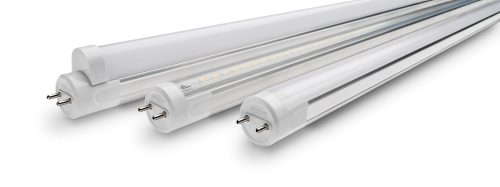
T8 LED tube lights, or TLEDs, have been a controversial topic in the lighting industry for several years. As recently as 2013, an Access Fixtures blog detailed 6 Reasons We Don’t Provide LED Tubes. (OUCH!) Then, in January of 2015, Access Fixtures announced New T8 LED Retrofit Tube Lights Introduced by Access Fixtures.
Times have surely changed, with T8 LED tube lights now becoming a viable mainstream product category.
Along with this improved product viability has come a constantly evolving plethora of variables that cause many lighting professionals, electrical contractors, and property managers to hesitate before making the change from linear fluorescent tubes to TLEDs.
So, how do you decide which setup is right for you?
Drivers tend to be the key factor in differentiating between LED tube types. Also, since LEDs and drivers generate heat, many of the variations between different types of TLEDs are heat-related.
There are six typical options for driver implementation in TLEDs, including internal and external drivers. Let’s determine the pros and cons for each.
Internal Driver – Parallel Driver
This is the most common style. The driver is placed in parallel with the tube.
Advantages:
- Prices have been greatly reduced over the years.
- There is familiarity with this form factor in the industry.
Disadvantages:
- Since they are located in close proximity, heat generated from the driver can damage the LEDs.
- When the driver fails, the entire tube needs to be replaced.
- Dimming is not always possible.
- An electrician needs to bypass the ballast for installation.
Internal Driver – Thermal isolation end-cap driver
This style places the driver in the end cap of the tube, instead of parallel to the LEDs.
Advantages:
- Prices have come down.
- The heat from the driver does not damage the LEDs.
Disadvantages:
- When the driver fails, the entire tube needs to be replaced.
- Dimming is not always possible.
- An electrician needs to bypass the ballast for installation.
Internal driver – Thermal Isolation and Replaceable driver
The internal LED driver is located at the end cap of the tube and is replaceable.
Advantages:
- The heat from the driver does not damage the LEDs.
- The driver is replaceable, which lowers costs associated with maintenance.
- Prices are competitive with other styles that have internal drivers.
Disadvantages:
- Dimming is not always possible.
- An electrician needs to bypass the ballast for installation.
Internal driver – Ballast-compatible driver
Ballast-compatible drivers, such as Philips InstaFit, clip into fluorescent tombstone connectors.
Advantages:
- No electrician is required for installation.
Disadvantages:
- When the original fluorescent ballast fails, another ballast needs to be purchased and installed by an electrician. The life of the ballast is often shorter than the life of the tube, increasing maintenance.
- The tube wattage is typically higher than other styles, which lowers efficacy.
External driver with power to pins
The external LED driver provides direct power to the tube pins.
Advantages:
- The heat from the driver does not damage the LEDs.
- It is compatible with dimming options and other smart control implementations.
- The driver is replaceable.
Disadvantages:
- An electrician needs to replace the ballast with the driver.
- Tubes with external drivers are typically more expensive.
External drivers connected directly to tubes
Advantages:
- The heat from the driver does not damage the LEDs.
- It is compatible with dimming options and other smart control implementations.
- The driver is replaceable.
- There is placement flexibility within the fixture
- If the tombstones are damaged, they do not need to be replaced.
- Utility companies typically prefer direct connection between drivers and LED tubes, rather than running line voltage directly into the existing fixture’s tombstones.
Disadvantages:
- An electrician needs to replace the ballast with the driver.
- The installer needs to mount a holder for the tubes.
- Tubes with external drivers are typically more expensive.
Access Fixtures TLEDs include internal drivers with direct AC input. These TLEDs offer a cost-effective alternative to linear fluorescent tubes, work well with automated controls, and enable a quick ROI. Although they require more upfront labor to remove the existing ballast, the resulting simplicity and savings are worth the extra cost. Using ballast-compatible drivers would result in having to replace each ballast when it fails. Considering the life of the ballast is likely shorter than that of the TLED, if the ballast is replaced each time it fails, the additional costs quickly add up.
Using only 19 watts, Access Fixtures TLEDs provide 100 lumens per watt and have a CRI of 90+. Compared to a T12 lamp and ballast, TLEDs generate double the lumens per watt, last three times as long, deliver 13% more light per tube, and reduce energy use by nearly 40%.
To learn more about TLEDs, check out our TLED Questions and Answers post, or contact an Access Fixtures’ lighting specialist.
